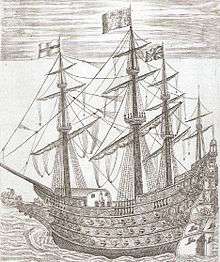William Rainsborough
| Captain William Rainsborowe | |
|---|---|
| Born |
11 June 1587 St Mary's Whitechapel London, England |
| Died |
16 February 1642 (aged 54) St Katharine's by the Tower, Wapping, London |
| Resting place | St John's Church, Wapping, London England |
| Occupation | Member of Parliament, Sea Mariner, Businessman |
Captain William Rainsborough (11 June 1587 – 16 Feb 1642) was an English Captain and Vice-Admiral in the Royal Navy, English ambassador to Morocco and politician who sat in the House of Commons from 1640 to 1642.
Naval expeditions
On the orders of Charles I of England, Rainsborough led a successful naval expedition against the Barbary corsairs of Salé in North West Morocco in June 1637. His exploits were hailed in a court masque designed by Inigo Jones[1] For his services to end white slavery Rainsborough was offered a hereditary knighthood, which he declined, and was presented with a Gold Chain and Medal by Charles I.[2] Captain Rainsborough's Emblem was a Saracen's head crest. The Saracen Head[3] as interpreted as 'the head of the foreigner'; the foreigner being the much-feared pirates of the north African coast. Usually referred to as Turks, these marauders were in the white slavery business. This emblem represented Captain Rainsborough's success at ending White Slavery against the Barbary pirates in Morocco in 1637.

MP for Aldeburgh Suffolk 1640
In April 1640, Rainsborough was elected Member of Parliament for Aldeburgh in the county of Suffolk in the Short Parliament. He was re-elected for Aldeburgh in November 1640 for the Long Parliament and held the seat until his death in 1642.[4]
Death 1642
Rainsborough died in 1642 and was buried at St Katharine's by the Tower on 16 February 1642.[5]
Father of Thomas Rainsborough
Rainsborough married Judith Horton, daughter of Renold and Joane Horton. Their sons Thomas Rainsborough and William Rainsborowe, two influential figures in the English Civil War, fought for the Roundheads.[6]
Gallery
_by_Claes_Van_Visscher.jpg) London Bridge in 1630's England
London Bridge in 1630's England
References
- ↑ Tinniswood, Adrian (2011). Pirates of Barbary: Corsairs, Conquests and Captivity in the 17th-Century Mediterranean. London: Vintage Books. ISBN 978-0099523864.
- ↑ Pinkerton, John (1790). The Medallic History of England to the Revolution. London.
- ↑ http://www.bbc.co.uk/ahistoryoftheworld/objects/sn9JsuYlSBGS4igDhaeYpA
- ↑ Willis, Browne (1750). Notitia Parliamentaria, Part II: A Series or Lists of the Representatives in the several Parliaments held from the Reformation 1541, to the Restoration 1660 ... London. pp. 229–239.
- ↑ Williams, William Retlaw (1897). The Parliamentary History of the county of Worcester. p. 13.
- ↑ Waters, Henry Fitz-Gilbert & Greenwood, Isaac John (1886). The Rainborowe Family.
- ↑ Rainsborough,Captain William ."1. Rainsborough, Col William (Charlestown, Mass, 1639)" London,14 October Retrieved on 14 October 2014.
Further reading
- Andrews, Kenneth R. (1991). Ships, money, and politics : seafaring and naval enterprise in the reign of Charles I. Cambridge, UK: Cambridge University Press. ISBN 978-0521401166.
- Tinniswood, Adrian (2013). The Rainborowes: Pirates, Puritans and a Family's Quest for the Promised Land. London: Jonathan Cape. ISBN 978-0224091480.
| Parliament of England | ||
|---|---|---|
| Preceded by Parliament suspended since 1629 |
Member of Parliament for Aldeburgh 1640 With: Squire Bence 1640 Alexander Bence 1640-1642 |
Succeeded by Squire Bence Alexander Bence |